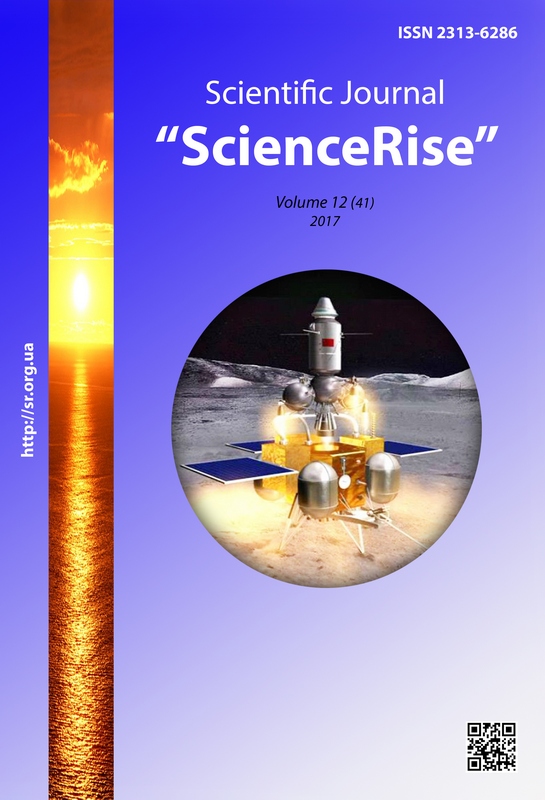Development of energy-saving electrical heating systems with night heat accumulation
DOI:
https://doi.org/10.15587/2313-8416.2017.118277Keywords:
energy saving, electrical heating, night heat accumulation, cost of different energy resourcesAbstract
It has been proposed a special method and program for electrical heating systems with night heat accumulation calculation as well for determine the monthly heat consumption of the building and estimate the cost of heating using different energy resources (centralized heat supply, gas heating, pellet heating).
It has been found that the cost of electric heating with night heat accumulation is two times lower than in the case of centralized heat supply
References
Robakevych, M., Panek, A. (2015). Termomodernyzatsyia zhyloho doma. Kyiv, 40.
Lazurenko, A. P., Cherkashina, G. I. (2009). Opredelenie potentsial'nogo ekonomicheskogo effekta ot vyravnivaniya grafika elektricheskoy nagruzki OES Ukrainy. Svіtlotekhnіka ta elektroenergetika, 1 (17), 4–12.
Malyarenko, V. A., Kolotilo, I. D., Shherbak, I. E. (2014). Potrebiteli-regulyatory kak effektivnoe napravlenie regulirovaniya grafika nagruzki elektricheskikh setey. Іntegrovanі tekhnologіi ta energozberezhennya, 1, 3–14.
Schweiger, G., Rantzer, J., Ericsson, K., Lauenburg, P. (2017). The potential of power-to-heat in Swedish district heating systems. Energy, 137, 661–669. doi: 10.1016/j.energy.2017.02.075
Munster, M., Morthorst, P. E., Larsen, H. V., Bregnbaek, L., Werling, J., Lindboe, H. H., Ravn, H. (2012). The role of district heating in the future Danish energy system. Energy, 48 (1), 47–55. doi: 10.1016/j.energy.2012.06.011
Romanchenko, D., Odenberger, M., Goransson, L., Johnsson, F. (2017). Impact of electricity price fluctuations on the operation of district heating systems: A case study of district heating in Goteborg, Sweden. Applied Energy, 204, 16–30. doi: 10.1016/j.apenergy.2017.06.092
Delangle, A., Lambert, R. S. C., Shah, N., Acha, S., Markides, C. N. (2017). Modelling and optimising the marginal expansion of an existing district heating network. Energy, 140, 209–223. doi: 10.1016/j.energy.2017.08.066
Ziemele, J., Gravelsins, A., Blumberga, A., Blumberga, D. (2017). Sustainability of heat energy tariff in district heating system: Statistic and dynamic methodologies. Energy, 137, 834–845. doi: 10.1016/j.energy.2017.04.130
Ziemele, J., Gravelsins, A., Blumberga, A., Blumberga, D. (2017). Combining energy efficiency at source and at consumer to reach 4th generation district heating: Economic and system dynamics analysis. Energy, 137, 595–606. doi: 10.1016/j.energy.2017.04.123
Guelpa, E., Barbero, G., Sciacovelli, A., Verda, V. (2017). Peak-shaving in district heating systems through optimal management of the thermal request of buildings. Energy, 137, 706–714. doi: 10.1016/j.energy.2017.06.107
Bianchini, G., Casini, M., Vicino, A., Zarrilli, D. (2016). Demand-response in building heating systems: A Model Predictive Control approach. Applied Energy, 168, 159–170. doi: 10.1016/j.apenergy.2016.01.088
Arteconi, A., Patteeuw, D., Bruninx, K., Delarue, E., D’haeseleer, W., Helsen, L. (2016). Active demand response with electric heating systems: Impact of market penetration. Applied Energy, 177, 636–648. doi: 10.1016/j.apenergy.2016.05.146
Matsevityy, Yu. M., Ganzha, N. G., Khimenko, A. V. (2011). Otsenka energeticheskoy effektivnosti sistem elektroteploakkumulyatsionnogo otopleniya administrativnykh zdaniy. Energosberezhenie. Energetika. Energoaudit, 10 (92), 9–16. Available at: http://www.kpi.kharkov.ua/archive/Наукова_періодика/eee/2011/10/19487.pdf
Ganzha, N. G., Khimenko, A. V. (2012). Teplovoe akkumulirovanie kak sposob povysheniya energeticheskoy effektivnosti sistem teplosnabzheniya. Energosberezhenie. Energetika. Energoaudit, 3 (97), 16–21.
Wang, H., Duanmu, L., Lahdelma, R., Li, X. (2017). Developing a multicriteria decision support framework for CHP based combined district heating systems. Applied Energy, 205, 345–368. doi: 10.1016/j.apenergy.2017.07.016
Li, J., Fang, J., Zeng, Q., Chen, Z. (2016). Optimal operation of the integrated electrical and heating systems to accommodate the intermittent renewable sources. Applied Energy, 167, 244–254. doi: 10.1016/j.apenergy.2015.10.054
Patteeuw, D., Bruninx, K., Arteconi, A., Delarue, E., D’haeseleer, W., Helsen, L. (2015). Integrated modeling of active demand response with electric heating systems coupled to thermal energy storage systems. Applied Energy, 151, 306–319. doi: 10.1016/j.apenergy.2015.04.014
Parasochka, S. O., Khriashchevskyi V. M. (2009). Do pytannia pro elektroakumuliatsiine opalennia ta hariache vodopostachannia. Zhytlovo-komunalne hospodarstvo Ukrainy, 8 (21), 34–37.
Paraska, H. B., Mykoliuk, O. A. (2015). Otsinka efektyvnosti vykorystannia elektrychnykh system opalennia. Enerhetyka: ekonomika, tekhnolohii, ekolohiia, 4, 73–79.
Treputnev, V. V. (2010). Elektricheskie teploakkumulyatory dlya otopleniya i goryachego vodosnabzheniya. Novosti teplosnabzheniya, 4 (116). Available at: http://journal.esco.co.ua/cities/2013_9/art171.pdf
Andriushchenko, A. M., Panasiuk, O. V. (2011). Pat. No. 57479 UA. Systema teplopostachannia. MPK F24D 3/08. No. u201010782; declareted: 06.09.2010; published: 25.02.2011, Bul. No. 4.
Natsionalna komisiia, shcho zdiisniuie derzhavne rehuliuvannia u sferakh enerhetyky ta komunalnykh posluh. Available at: http://www.nerc.gov.ua/?id=11889
Preiskurant na pryrodnyi haz z 1 lystopada 2017 roku. Available at: http://www.naftogaz.com/files/Information/Naftogaz-gas-prices-ne-PSO-November-2017.pdf
Prodazha pellet. Available at: http://www.pelletex.com.ua/
Downloads
Published
Issue
Section
License
Copyright (c) 2017 Anatoly Andryushchenko, Vladimir Nikulshin vnikul@paco.net, Alla Denysova

This work is licensed under a Creative Commons Attribution 4.0 International License.
Our journal abides by the Creative Commons CC BY copyright rights and permissions for open access journals.
Authors, who are published in this journal, agree to the following conditions:
1. The authors reserve the right to authorship of the work and pass the first publication right of this work to the journal under the terms of a Creative Commons CC BY, which allows others to freely distribute the published research with the obligatory reference to the authors of the original work and the first publication of the work in this journal.
2. The authors have the right to conclude separate supplement agreements that relate to non-exclusive work distribution in the form in which it has been published by the journal (for example, to upload the work to the online storage of the journal or publish it as part of a monograph), provided that the reference to the first publication of the work in this journal is included.

